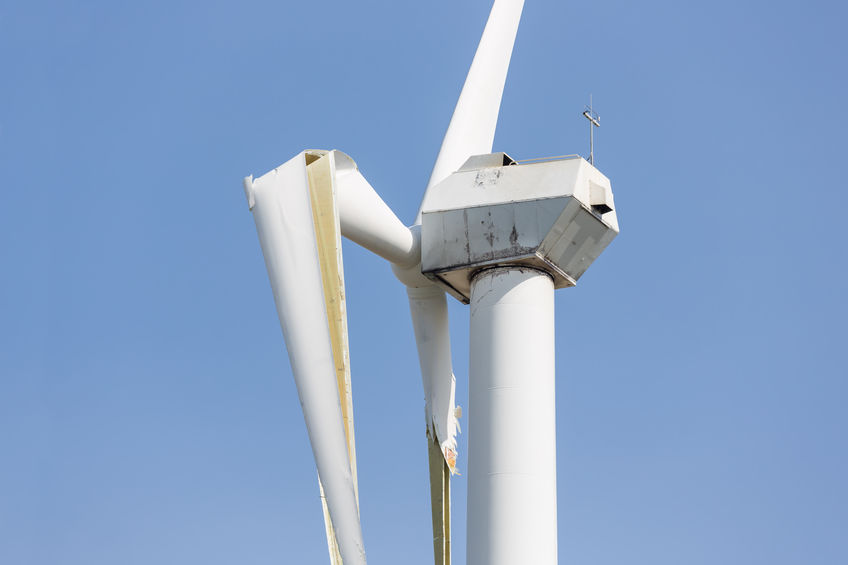Contrary to popular opinion, the life cycle of a modern wind turbine is no more than 20 to 25 years. Since turbine blades cannot be burned and are not recyclable, the recommended option is landfill disposal. But not every landfill can even accept these massive structures, even after they are broken into their parts.
According to Pu Liu and Claire Barlow (Waste Management, April 2017), there will be 43 million metric tons of blade waste worldwide by 2050, with China possessing 40% of the waste, Europe 25%, the United States 16%, and the rest of the world 19%. The problem of blade disposal, they conclude, is just beginning to emerge as a significant factor for the future.
A 2017 report from researchers Katerin Ramirez-Tejeda, David A. Turcotte, and Sarah Pike (New Solutions) asserts that “the environmental consequences and health risks are so adverse that the authors warn that if the public learns of this rapidly burgeoning problem, they may be less inclined to favor wind power expansion.”
Ramirez-Tejeda, et al., added that landfilling turbine waste is especially problematic “because its high resistance to heat, sunlight, and moisture means that it will take hundreds of years to degrade in a landfill environment. The wood and other organic material present in the blades would also end up in landfills, potentially releasing methane, a potent greenhouse gas, and other volatile organic compounds to the environment.”
At current U.S. landfilling costs of about $60 per ton, the 40-ton monsters may provide short-term revenues for landfill operators. The long-term cost (including for pretreatment and transportation), together with community opposition to landfill expansion) is making turbine blade disposal a major emerging problem in the U.S. and worldwide.
Evidence of these difficulties is already emerging in the American heartland. The City of Casper, Wyoming, in July finally released a statement confirming the disposal of wind turbine blades in the Casper Regional Solid Waste Facility. The city says the facility has been accepting fiberglass wind turbine blades, that are being replaced, for disposal.
City officials justified their actions, stating that, “Destroying the blades requires compacting equipment more powerful and larger than the Casper Regional Solid Waste Facility has. Disposal in a landfill is a viable option as fiberglass is a material that does not leach components into the soil or groundwater and thus can be buried in an unlined landfill.”
City Manager Carter Napier commented, “The citizens of Casper can be satisfied in knowing that years of planning and proactive development pays off with projects of this nature.” Napier assured citizens that, “the revenue that is received from this project will ultimately benefit our entire community.”
City officials further explained that the Casper Regional Solid Waste Facility is the only landfill in the region that has both the national certifications required by the federal government to dispose of materials in an environmentally friendly manner and an unlined landfill large enough to handle the project.
Meanwhile, in Sioux Falls, Iowa, city officials have announced that Iowa wind farm operators brought 101 old turbine blades to the city dump this summer. However, City Hall promised it would not take any more turbine blades unless their owners take more steps to make the massive fiberglass pieces less space consuming.
The reason, according to Public Works Director Mark Cotter: “We can’t take any more unless they process them before bringing them to us. We’re using too many resources unloading them, driving over them a couple times, and working them into the ground.” Landfill crews, upon receiving each of the 120-foot-long blades (broken into three sections), crush the hollowed-out structures beneath the weight of 60-ton trucks.
In the future, city officials have determined, wind energy companies must break blades into pieces no larger than 3 feet long – through a grinding or shearing process. Sioux Falls is also planning a pilot study to determine the feasibility of sheering blades on site, the impact on air space at the landfill, and if pricing for accepting them [currently $64 per ton] should be changed.
Ultimately, according to Sarah Lozanova (Earth911, August 2017), decommissioning wind farms might be more costly than the construction phase. Indeed, she added, decommissioning and recycling wind turbines is a blind spot when considering the total environmental impact of wind energy.
Casper and Sioux Falls landfill operators are on the front lines of this massive emerging problem. Casper claims positive revenues, but Sioux Falls says they are losing money. One thing is certain: The costs and hassle (and waste of limited landfill space) of disposing of millions of tons of turbine blades must be factored into the cost-benefit for any wind project.
